IMAX
IMAX is a proprietary system of high-resolution cameras, film formats, film projectors, and theaters known for having very large screens with a tall aspect ratio (approximately either 1.43:1 or 1.90:1) and steep stadium seating.
Graeme Ferguson, Roman Kroitor, Robert Kerr, and William C. Shaw were the co-founders of what would be named the IMAX Corporation (founded in September 1967 as Multiscreen Corporation, Limited), and they developed the first IMAX cinema projection standards in the late 1960s and early 1970s in Canada.[1] Unlike conventional film projectors, the film runs horizontally so that the image width can be greater than the width of the film stock.
History

The IMAX film standard uses 70 mm film run through the projector horizontally. This technique produces an area that is nine times larger than the 35 mm format, and three times larger than 70 mm film which was run conventionally through the projector in a vertical orientation.[2]
The desire to increase the visual impact of film has a long history. In 1929, Fox introduced Fox Grandeur, the first 70 mm film format, but it quickly fell from use.[3] In the 1950s, the potential of 35 mm film to provide wider projected images was explored in the processes of CinemaScope (1953) and VistaVision (1954), following multi-projector systems such as Cinerama (1952). While impressive, Cinerama was difficult to install and maintain, requiring careful alignment and synchronization of the multiple projectors. During Expo 67 in Montreal, the National Film Board of Canada's In the Labyrinth and Ferguson's Man and the Polar Regions both used complex multi-projector, multi-screen systems. Each encountered technical difficulties that led them to found a company called "Multiscreen", with a goal of developing a simpler approach.
Multiscreen Corporation
The single-projector/single-camera system they eventually settled upon was designed and built by Shaw based upon a novel "Rolling Loop" film-transport technology purchased from Peter Ronald Wright Jones, a machine shop worker from Brisbane, Australia.[4] Film projectors do not continuously flow the film in front of the bulb, but instead "stutter" the film travel so that each frame can be illuminated in a momentarily-paused still image. This requires a mechanical apparatus to buffer the jerky travel of the film strip. The older technology of running 70 mm film vertically through the projector used only five sprocket perforations on the sides of each frame; however, the IMAX method used fifteen perforations per frame.[2] The previous mechanism was inadequate to handle this intermittent mechanical movement that was three times longer, and so Jones's invention was necessary for the novel IMAX projector method with its horizontal film feed. As it became clear that a single, large-screen image had more impact than multiple smaller ones and was a more viable product direction, Multiscreen changed its name to IMAX. Cofounder Graeme Ferguson explained how the name IMAX originated:
"... the incorporation date [of the company was] September 1967. ... [The name change] came a year or two later. We first called the company Multiscreen Corporation because that, in fact, was what people knew us as. ... After about a year, our attorney informed us that we could never copyright or trademark Multivision. It was too generic. It was a descriptive word. The words that you can copyright are words like Kleenex or Xerox or Coca-Cola. If the name is descriptive, you can't trademark it so you have to make up a word. So we were sitting at lunch one day in a Hungarian restaurant in Montreal and we worked out a name on a placemat on which we wrote all the possible names we could think of. We kept working with the idea of maximum image. We turned it around and came up with IMAX."[5]
The name change actually happened more than two years later, because a key patent filed on January 16, 1970, was assigned under the original name Multiscreen Corporation, Limited.[6] IMAX Chief Administration Officer Mary Ruby was quoted as saying, "Although many people may think "IMAX" is an acronym, it is, in fact, a made-up word."[7]
IMAX Corporation
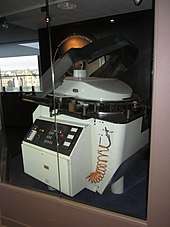
Tiger Child, the first IMAX film, was demonstrated at Expo '70 in Osaka, Japan.[8] The first permanent IMAX installation was built at the Cinesphere theatre at Ontario Place in Toronto. It debuted in May 1971, showing the film North of Superior. The installation remained in place[9] during Ontario Place's hiatus for redevelopment. The Cinesphere was renovated while Ontario Place was closed and re-opened on November 3, 2017 with IMAX 70mm and IMAX with laser illumination.[10]
During Expo '74 in Spokane, Washington, an IMAX screen that measured 27 m × 20 m (89 ft × 66 ft) was featured in the US Pavilion (the largest structure in the expo). It became the first IMAX Theatre to not be partnered with any other brand of movie theatres. About five million visitors viewed the screen, which covered the viewer's total visual field when looking directly forward. This created a sensation of motion in most viewers, and motion sickness in some.
Another IMAX 3D theatre was also built in Spokane; however, its screen-size is less than half. Due to protests, the City of Spokane officials decided to work with the IMAX Corporation to demolish the theatre, under the condition they renovate the former US Pavilion itself into IMAX's first permanent outdoor giant-screen theatre. The plan was to use material on the inside of the structure similar to that used when first constructed. However, it was expected to last only five years, due to weather conditions destroying previous materials.[11] Concept art has been released in videos featured on Spokane's renovation site, and its budget revealed that seating is planned for more than 2,000.[12][13]
The first permanent IMAX Dome installation, the Eugene Heikoff and Marilyn Jacobs Heikoff Dome Theatre at the Reuben H. Fleet Science Center, opened in San Diego's Balboa Park in 1973. It doubles as a planetarium theater. The first permanent IMAX 3D theatre was built in Vancouver, British Columbia for Transitions at Expo '86, and was in use until September 30, 2009.[14] It was located at the tip of Canada Place, a Vancouver landmark.
Digital projection
In 2008, IMAX extended its brand into traditional theaters with the introduction of Digital IMAX, a lower-cost system that uses two 2K digital projectors to project on a 1.90:1 aspect ratio screen. This lower-cost option, which allowed for the conversion of existing multiplex theater auditoriums, helped IMAX to grow from 299 screens worldwide at the end of 2007 to over 1,000 screens by the end of 2015.[15][16] As of September 2017, there were 1,302 IMAX theatres located in 75 countries, of which 1,203 were in commercial multiplexes.[17]
The switch to digital projection came at a steep cost in image quality, with 2K projectors having roughly an order of magnitude less resolution than traditional IMAX film projectors. Maintaining the same 7-story screen size would only make this loss more noticeable, so many new theaters were instead built with significantly smaller screens. These newer theaters with much lower resolution and much smaller screens soon began to be referred to by the derogatory name "LieMAX", particularly because the company still marketed the new screens similarly to the old ones, without making the major differences clear to the public, going so far as to market the smallest "IMAX" screen, having 10 times less area, similarly to the largest while persisting with the same brand name.[18][19]
Since 2002, some feature films have been converted into IMAX format for displaying in IMAX theatres, and some have also been (partially) shot in IMAX. By late 2017, 1,302 IMAX theatre systems were installed in 1,203 commercial multiplexes, 13 commercial destinations, and 86 institutional settings in 75 countries,[20] with less than a quarter of those having the capability to show 70mm film at the resolution of the large format as originally conceived.
Technical aspects
Camera
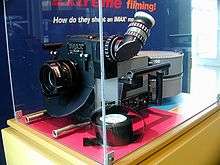
Film cameras
The IMAX cinema process increases the image resolution by using larger film frame; in relative terms, a frame of IMAX format film has three times the theoretical horizontal resolution of a frame of 35mm film.[21] To achieve such increased image resolution, which IMAX estimates at approximately 12,000 lines of horizontal resolution (12K),[22] 65mm film stock passes horizontally through the IMAX movie camera, 15 perforations at a time. At 24 frames per second, this means that the film moves through the camera at 102.7 metres per minute (just over 6 km/h). In a conventional 65mm camera, the film passes vertically through the camera, five perforations at a time, or 34 metres per minute. In comparison, in a conventional 35mm camera, 35mm film passes vertically through the camera, at four (smaller) perforations at a time, which translates to 27.4 metres per minute.[21]
In the Todd-AO 70mm-format of widescreen cinema, the image area of a 65mm film-frame is 48.5 mm × 22.1 mm (1.91 in × 0.87 in); in the IMAX-format of widescreen cinema, the film-frame dimensions are 69.6 mm × 48.5 mm (2.74 in × 1.91 in). To match the standard image resolution of the moving image produced with the film-speed of 24 frames per second, an IMAX film requires three times the length of (negative) film stock required for a 65mm film of comparable scope and cinematic technique.
Phantom 65 IMAX 3D digital camera
In 2011, IMAX announced a 4K 3D digital camera. The camera was developed alongside Vision Research and AbelCine, integrating two Phantom 65 engines. A prototype camera was used for the documentary Born to be Wild, in which approximately 10% of the finished film was shot with the system.[23] The company has said they have no intention of replacing the higher resolution film cameras with the new digital camera, but the latter can be used in scenes that require a lightweight or relatively small 3D camera. While IMAX has completed the production camera and has placed it in service on several films, they have no plans to produce an IMAX film solely with the new digital system. Transformers: Age of Extinction is the first feature film partially filmed with the Phantom 65 IMAX 3D camera.[24]
ARRI Alexa IMAX digital camera
In 2015, IMAX announced a 2D digital camera that was developed alongside Arri, the camera being based on the latter company's Arri Alexa 65 technology. The first production to use the camera was Captain America: Civil War. The Russo brothers have stated that they solely used the Arri Alexa IMAX on Avengers: Infinity War (2018) and Avengers: Endgame (2019).[25]
For Transformers: The Last Knight, two ARRI Alexa IMAX cameras were combined in a rig to provide native 3D, with the film containing 98% of IMAX footage.[26]
Film stock
The IMAX format is generically called "15/70" film, the name referring to the 15 sprocket holes or perforations per frame. The film's bulk and weight require horizontal platters, rather than conventional vertically-mounted film reels. IMAX film is fed through the projector vertically,[27] and the film is drawn from the inner circumference of the platter, not from the outer circumference like in conventional film reels. A system is in place to keep the film in the outer circumference from flying outwards due to centrifugal force while the platter is spinning. IMAX film is shipped to theaters in several small reels that are spliced into one continuous length that is then wound into a platter, a process that may take hours to complete. Films may be several kilometers in length: Avatar, which was 2:45 hours long, was close to 16 kilometers long. Platters are handled using special forklifts.[28] IMAX platters range from 1.2 to 1.83 meters (3.9 to 6.0 ft) diameter to accommodate 1 to 2.75 hours of film. Platters with a 2.5 hour feature film weigh 250 kilograms (550 lb). IMAX uses ESTAR-based print film[29] in their 15/70 rolling-loop film projection systems. ESTAR-based print film provides greater precision. The chemical development process does not change the size or shape of ESTAR print film, and IMAX's pin registration system (especially that of the camera mechanism) does not tolerate either sprocket-hole or film-thickness variations, but the film can still swell or shrink under varying temperature and humidity, this requires projection booths to be kept at a temperature of between 20 and 23.8°C and a humidity of 50%.[28] The film is too large to be moved using its sprokets,[30] so they are instead used for registration, to aid in aligning the film. A feature film platter can cost US$36,000 to print. The camera negative is actually 65mm film stock, but it runs horizontally and with 15 perforations per frame.[31] The camera, like the projector, has a vacuum system; this makes the camera noisy, forbidding the recording of quiet scenes. The camera has enough film for 3 minutes of shooting. The large frame of the film also imposes optical limitations such as an extremely shallow field of view when shooting with an open aperture. [32]
Soundtrack - double-system
To use more of the image area, IMAX film does not include an embedded soundtrack. Instead, the IMAX system specifies a separate six-channel 35 mm (1.4 in) magnetic film, recorded and played back on a film follower locked to picture, just as Vitaphone had been (utilizing 16-inch 33 1/3 RPM electrical transcription discs) in the early 20th century, and was the same technology used to provide the 7-channel soundtrack accompanying films photographed and exhibited in the Cinerama process in the mid-1950s. By the early 1990s, a separate DTS-based 6-track digital sound system was used, similarly locked to the projector by a SMPTE time code synchronization apparatus, the audio played off a series of proprietarily encoded CD-ROM discs. In the late 1990s, IMAX upgraded this system to use a hard drive that carries a single uncompressed audio file that contains the six channels. These are converted directly to analogue rather than processed through a decoding method such as DTS.
Like conventional theatres, IMAX theatres place speakers both directly behind the acoustically-transparent screen, and around the theatre to create a "surround sound" effect. IMAX also provides a "top center" speaker in addition to the centre speaker found in conventional theatres. This extra channel allows the sound mix engineers to take advantage of the screen's greater height.[33]
Projectors
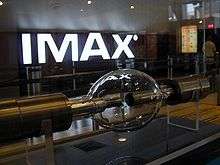
Transporting the large film stock through the optical system presented challenges for both the camera and the projector. Conventional 70 mm systems were not steady enough for the 586× magnification. On the projector side, William Shaw adapted an Australian patent for film transport called the "rolling loop" by adding a compressed air "puffer" to accelerate the film, and put a cylindrical lens in the projector's "aperture block".[34]
The projector uses a vacuum to pull the film into contact with this lens. Thus the "field flattener" flattens the image field. The lens is twice the height of the film and connects to a pneumatic piston so it can be moved up or down while the projector is running. This way, if a piece of dust comes off the film and sticks to the lens, the projectionist can switch to a clean portion of the lens at the push of a button. The lens also has "wiper bars" made of a felt or brush-like material that wipes dust off the lens as it moves up or down. The projector uses a vacuum to keep the film flat and oriented correctly for projection.[31] The shutter of an IMAX projector is also kept open for longer than a 35mm projector shutter to increase image brightness.[30]
IMAX projectors are pin-stabilized; this means that four registration pins engage the perforations at the corners of the projected frame to ensure perfect alignment. Shaw added cam-controlled arms to decelerate each frame to eliminate the microscopic shaking as the frame "settled" onto the registration pins. The projector's shutter is open around 20% longer than in conventional equipment, and the light source is brighter. The xenon short-arc lamps are made with a thin envelope of fused quartz and contain xenon gas at a pressure of about 25 atmospheres (367 psi (2,530 kPa)). Because of this, projectionists are required to wear protective body armor when changing or handling the lamp in case it breaks (e.g., due to a drop to the floor) because of the danger from flying quartz shards propelled by the high pressure of the xenon gas within; this applies to all projection xenon lamps. An IMAX xenon lamp runs on DC power, lasts for 1000 hours and requires its own pump and water cooler, also the projector's optics require compressed air cooling. [28] An IMAX projector weighs up to 1.8 tonnes (2 short tons)[30] and is over 178 cm (5.8 ft) tall and 195 cm (6.4 ft) long. The projector is raised and locked into position before each screening.[28]
IMAX Corporation has released four projector types that use its 15-perforation, 70 mm film format: GT (Grand Theatre), GT 3D (dual rotor), SR (Small Rotor), and MPX, which was designed for retrofitted theatres.[35] In July 2008, the company introduced a digital projection system, which it has not given a distinct name or brand, designed for multiplex theatres with screens no wider than 21.3 m (70 ft). All IMAX projectors, except the standard GT system, can project 3D images. GT 3D projectors require two separate lamps and polarized projection optics.[31]
Digital projection

The digital cinema IMAX projection system, debuted in 2008, is designed to use with shorter 1.90:1 aspect ratio screens. The system uses two 2K projectors that can present either 2D or 3D content in DCI or IMAX Digital Format (IDF) (which in itself is a superset of DCI). IDF initially used 2K-resolution Christie xenon projectors, with a Texas Instruments Digital Light Processing (DLP) engine, but in 2012 IMAX announced that they would be switching to Barco as their primary supplier.[36] The two 2K images are projected superimposed on each other with a half-pixel offset, using super-resolution imaging to increase the perceived resolution to approximately 2.9K.
For 3D presentations, one projector is used to display the image for each eye, while 2D presentations use the superimposed images to allow for a brighter 22-foot lambert image. The Digital IMAX projection system includes a proprietary IMAX Image Enhancer that modifies the output of the digital media server based on feedback from cameras and microphones in the auditorium, and maintains alignment with sub-pixel accuracy.[37]
Mainly because the system facilitates inexpensive distribution of IMAX features, the company announced in February 2012 that they were re-renovating specially selected locations around the world to present both 70mm analog as well as digital presentations. To do so, IMAX developed a rail system that moves the projectors in and out to accommodate either a full-frame film print or a digital-only release. These theaters were prepared in time for the release of The Dark Knight Rises in July 2012.[38]
Laser projection
In April 2012, IMAX began testing a new 4K laser projection system, based on patents licensed from Eastman Kodak. Like the 3D film and digital systems, it used two projectors, but it improved over the smaller digital screens by retaining the traditional IMAX aspect ratio and let films be shown on screens 36 m (118 ft) wide or more.[39] In December 2014, IMAX began rolling out its new Dual 4K laser projector system, dubbed "IMAX with Laser", with the first installation occurring at the Cineplex ScotiaBank Theatre in Toronto.[40][41] The system allows digital projection on the full 1.43:1 aspect ratio surface of a traditional IMAX screen, but can also be used on wider screens such as the 1.90:1-aspect-ratio TCL Chinese Theater.
The system replaces the xenon arc lamp of a traditional digital projector with a laser light source, and is capable of 60 fps with "50 percent greater" brightness than the Digital Cinema Initiatives spec, a contrast ratio "double" that of IMAX 15/70mm film projection and "higher" than the 2500:1 contrast ratio of IMAX's xenon lamp-based projection systems, and displaying the full Rec. 2020 color gamut/space. The system also features a new 12-channel surround sound system, which adds an additional speaker on either side of the theater as well as four new overhead speakers.[42][43]
While still not matching the theoretical resolution of traditional IMAX film, which is estimated at up to 12 thousand lines of horizontal resolution on the 65mm camera negative (12K) and approximately 6 thousand on a 35mm release print (6K),[22] the new laser system features dual-4K resolution projectors, each capable of displaying four times the detail of one Digital IMAX projector. Like Digital IMAX, images from the two projectors are projected superimposed on each other with a half-pixel offset, using super-resolution imaging, which makes the perceived resolution greater than 4K.[44] In-theater cameras and microphones are used to automatically calibrate the projectors and sound system between showings.[45] For 3D presentations, one projector is used to display the image for each eye, while 2D presentations use the superimposed images to allow for a brighter image.[43] For 3D presentations, IMAX with Laser systems use dichroic filter glasses, similar to those used by Dolby 3D, as opposed to the linear polarization glasses used in Digital IMAX theaters.[46]
On April 24, 2018, IMAX announced that they would begin rolling out a new single-unit version of their laser projector system later that year, with this iteration designed to replace the IMAX Xenon digital projection system for 1.90:1 screens.[47]
Theatres
IMAX theatres are described as either "Classic Design" (purpose-built structures), or "Multiplex Design" (retrofitted auditoriums).[48] Classic IMAX theatre construction differs significantly from conventional theatres. The increased resolution lets the audience be much closer to the screen. Typically all rows are within one screen height — conventional theatre seating runs 8 to 12-screen heights. Also, the rows of seats are set at a steep angle (up to 30° in some domed theatres) so that the audience is facing the screen directly.[49] A standard IMAX screen is 22 m × 16.1 m (72 ft × 53 ft), but can be significantly larger.
Until 2016, the world's largest IMAX screen was in Darling Harbour, Sydney, Australia, and measured 35.72 m × 29.57 m (117.2 ft × 97.0 ft).[50][51] Since then, the current largest operating IMAX screen is in Melbourne, Australia and measures 32 m × 23 m (105 ft × 75 ft).[52] The Sydney IMAX reconstruction, which began in 2016 and is due to be completed in late 2020,[53] includes an even larger screen ensuring it retains the record as the largest IMAX screen.[54]
Variations
Dome and Omnimax


.svg.png)
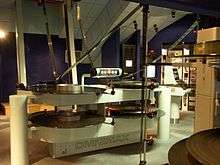

In the late-1960s, the San Diego Hall of Science (now known as the Reuben H. Fleet Science Center) began searching North America for a large-format film system to project on the dome of their planned 23.16 m (76.0 ft) tilted dome planetarium. The standard IMAX projector was unsuitable for use inside a dome because it had a 3.65 m (12.0 ft) tall lamp house on top. IMAX Corporation redesigned its system, adding an elevator to lift the projector to the center of the dome from the projection booth below. Spectra Physics designed a suitable lamphouse that took smaller, 46 cm (18 in) lamps and placed the bulb behind the lens instead of above the projector. In 1970,[55] Ernst Leitz Canada, Ltd. (now ELCAN Optical Technologies) won a contract to develop and manufacture a fisheye lens projection system optimized to project an image onto a dome instead of a flat screen.
The dome system, which the San Diego Hall of Science called "Omnimax", uses films shot with a camera equipped with a fisheye lens that squeezes a highly-distorted anamorphic 180° field of view onto the 65 mm IMAX film. The lens is aligned below the center of the frame, and most of the bottom half of the circular field falls beyond the edge of the film. The part of the field that would fall below the edge of the dome is masked. When filming, the camera is aimed upward at an angle that matches the tilt of the dome. When projected through a matching fisheye lens onto a dome, the original panoramic view is recreated. Omnimax wraps 180° horizontally, 100° above the horizon and 22° below the horizon for a viewer at the center of the dome. Omnimax premiered in 1973, showing Voyage to the Outer Planets (produced by Graphic Films) and Garden Isle (by Roger Tilton Films) on a double bill. IMAX has since renamed the system "IMAX Dome", but some theaters (primarily those opened before the 2000s) continue to call it "Omnimax".
IMAX Dome theatres are used in theme parks and many North American museums, particularly those with a scientific focus, where the technical aspects of the system may be highlighted as part of the attraction. The projection room is often windowed to allow public viewing of the equipment in operation, and it is often accompanied by informational placards like other exhibits. For some theaters, before the show begins, the screen can be backlit to show the speakers and girders behind it.
The screen may be a permanent fixture, such as at the Museum of Science and Industry (Henry Crown Space Center) in Chicago, Illinois; the Fort Worth Museum of Science and History; the Franklin Institute in Philadelphia, Pennsylvania; the St. Louis Science Center; Boston's Museum of Science; Richmond's Science Museum of Virginia; the Charlotte Observer IMAX Dome Theatre at Discovery Place, Charlotte, North Carolina; Birmingham, Alabama's McWane Science Center; US Space and Rocket Center in Huntsville, Alabama; the Cincinnati Museum Center at Union Terminal and Great Lakes Science Center in Cleveland, Ohio, and the Ontario Science Centre in Toronto, Ontario, Canada.
Alternatively, the dome may be lowered and raised as needed, such as at the Science Museum of Minnesota, and the former installation at the Canadian Museum of History (where it shared an auditorium with a standard IMAX screen, all replaced with a Barco CINE+ digital theatre system in 2016).[56] The entire dome could be raised to show flat screen features, and repositioned for immersive features.
While the majority of museum installations focus on educational and documentary films, on special occasions entertainment films are also shown, such as Charlie and the Chocolate Factory at the Oregon Museum of Science and Industry. The largest screen in North America is at the Science World in Vancouver, British Columbia, which has a dome screen 27 metres (89 ft) in size.
Due to the age of the IMAX Dome format as well as its entirely analogue nature, some theatres may opt to replace their existing IMAX Dome systems with newer, more versatile digital systems. Examples of former IMAX Dome theatres that have had their IMAX equipment replaced with newer equipment include Tietomaa Science Centre in Oulu, Finland (which replaced its IMAX 8/70 equipment from 1988 with a Barco DP4K-32B 4K projection system in 2013),[57] the Omni-Theatre at Science Centre Singapore,[58] the National Museum of Natural Science[59] in Taichung, Taiwan (which both had their original IMAX Dome 1570 projection systems installed respectively in 1987 and 1985 replaced with Evans & Sutherland Digistar 5 8K digital systems in 2015), and the Jennifer Chalsty Planetarium at Liberty Science Center in Jersey City, New Jersey, which replaced its IMAX Dome 1570 projection system from 1993 (when built was the largest IMAX Dome/OMNIMAX theatre in the world) with an Evans & Sutherland Digistar 6 "True8K" digital system in 2017.[60]
In November 2018, the Hackworth IMAX dome in The Tech Museum (now The Tech Interactive) replaced its 70mm IMAX projector with a 4K IMAX Laser projector. It became the first digital IMAX Laser dome theater in the world.
3D
To create the illusion of depth, the IMAX 3D process uses two separate camera lenses that represent the left and right eyes. The lenses are separated by a distance of 64 mm (2.5 in), the average distance between a human's eyes. Two separate rolls of film are used to capture the images they produce. The IMAX 3D camera weighs over 113 kg (249 lb). By projecting the two films superimposed on the screen and using one of several available methods to direct only the correct image to each eye, viewers see a 3D image on a 2D screen. One method is to use polarizing filters to oppositely polarize the light used in projecting each image. The viewer wears glasses with polarizing filters oriented to match the projector filters, so that the filter over each eye blocks the light used to project the images intended for the other eye. In another method, the two projections rapidly alternate. While one image is being shown, the projection of its mate is blocked. Each frame is shown more than once to increase the rate and suppress flicker. The viewer wears shutter glasses with liquid crystal shutters that block or transmit light in sync with the projectors, so each eye sees only the images meant for it.
Several of the early films that had been produced in digital 3D for release in conventional theaters were also presented in IMAX 3D, including Avatar, Gravity and The Amazing Spider-Man. The first full-color IMAX 3D film was the 1986 short documentary Transitions, produced for Expo 86 in Vancouver.[61]
HD
Variations on IMAX included the 48 frames per second IMAX HD process, which sought to produce smoother, more lifelike motion, while also reducing the blurring of moving objects, by doubling the normal film rate. The IMAX HD system was tested in 1992 at the Canada Pavilion of the Seville Expo '92 with the film Momentum.[62] Higher production costs, and the high "wear-and-tear" on the prints and projectors, doomed the IMAX HD system, but, not before many theatres had been retrofitted to project at 48 frames, especially in Canada, in order to play Momentum. In the 1990s theme parks in Thailand, Germany, and Las Vegas used IMAX HD for their Motion Simulator rides.[63] The Disney parks attraction Soarin' Over California features a modification of both IMAX HD and IMAX Dome, projecting in 48 frames per second.
Digital
Because 70mm film and projectors are costly and difficult to mass produce, and because the size of auditoriums that house full-size IMAX screens make them expensive to construct, IMAX debuted a digital projection system in 2008 to use with shorter 1.90:1 aspect ratio screens. It uses two 2K-resolution projectors that can present either 2D or 3D content in DCI or IMAX Digital Format (IDF) (which in itself is a superset of DCI). The digital installations have caused some controversy, as many theaters have branded their screens as IMAX after merely retrofitting standard auditoriums with IMAX digital projectors. The screen sizes in these auditoriums are much smaller than those in the purpose-built auditoriums of the original 15/70 IMAX format, and are limited to the 1.90:1 aspect ratio. Another disadvantage is the much lower resolution of digital IMAX. The technology has a maximum perceived resolution of 2.9K, compared to traditional IMAX 70mm projection, which has an estimated resolution of 12K.[22][37][64] Some reviewers have also noted that many non-IMAX theaters are projecting films at 4K resolution through competing brands such as Dolby Cinema and UltraAVX.
IMAX has held to a uniform branding of "The IMAX Experience" across various underlying technologies and screen sizes.[65] Some have criticized the company's marketing approach,[66] with the format being dubbed "Lie-MAX".[67] The company has defended the format by saying it has a bigger screen, brighter picture and better sound than standard theatres.[68] Despite the differences with digital IMAX, the cost-effective format has aided in the company's worldwide growth, especially in Russia and China.
IMAXShift
In May 2016, IMAX announced the test launch of IMAXShift, a multimedia indoor cycling concept,[69] but decided to discontinue it June 4, 2017.[70]
Virtual reality
On September 2, 2016, IMAX announced plans to include virtual reality (VR) into the IMAX theater experience with the opening of a new VR center in Los Angeles that would use a new StarVR headset created by Acer. The VR experience was intended for short but interactive videos.[71] IMAX opened a total of seven IMAX VR centers and established a US$50 million fund for the creation of VR content, as well as partnering with Google for the production of IMAX VR cameras.[72][73] However, as of December 2018, four out of the seven IMAX VR centers have closed, and the remaining three are slated to close in early 2019.[72]
Films
Entertainment
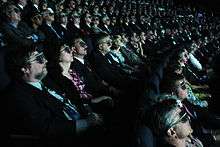
In the US, IMAX has mostly been used for specialty applications. The expense and logistical challenges of producing and presenting IMAX films have led to approximately 40 minute shorter running times than conventional films. Most are documentaries suited for institutional venues such as museums and science centers. IMAX cameras have been used while orbiting the Earth, climbing Mount Everest, exploring the bottom of the Atlantic Ocean, and visiting the Antarctic. A film about the Mars Exploration Rovers, titled Roving Mars (2006), used exclusive data from the rovers.[48]
An early attempt at presenting mainstream entertainment in IMAX format was The Rolling Stones: Live at the Max (1991), an 85-minute compilation of concert footage filmed in IMAX during the rock band's 1990 Steel Wheels tour, edited to give the impression of a single concert. In the 1990s, more entertainment short films were created, notably T-Rex: Back to the Cretaceous in 1998, and Haunted Castle in 2001 (both in 3D). In 1995, French director Jean-Jacques Annaud directed Wings of Courage, the first dramatic picture shot for IMAX. In 1998 and 1999, More and The Old Man and the Sea became the first short films produced using the IMAX format; both earned Academy Award nominations, with Old Man and the Sea becoming the only IMAX film to win an Oscar. In 2000, Disney produced Fantasia 2000, the first full-length animated feature initially released exclusively in the IMAX format.
Use in Hollywood productions
Before the end of the 1990s, theatrical features were deemed impossible to run in IMAX venues at the time, as there was a technical limitation on the size of the film reel where films had to run around two hours. Originally, IMAX and Pixar considered releasing Toy Story in IMAX 3D, but test results showed that the render resolution could not match the size of the IMAX image.[74] DreamWorks in the early 2000s wanted to re-release Shrek in IMAX 3D, but this too was canceled as a result of creative changes in the studio.[75] These failed attempts at re-releases did inspire IMAX to experiment and improve their ability in presenting computer animation in their theaters. Their compilation CyberWorld was the result, which contained new original animation and IMAX-presented versions of computer animated tests and music videos. Cyberworld even presented open-matte 3D versions of the bar sequence from Antz and the "Homer3" segment from The Simpsons; both coincidentally were animated at Pacific Data Images.
Walt Disney Pictures became the first studio to release theatrical films in the IMAX process. Released on New Year's Day in 2000, Fantasia 2000 was the studio's first IMAX release and the first theatrical feature presented in IMAX theaters. It was originally planned as a standard theatrical release, but in agreeing with the company to release the film, the IMAX sound system incorporated a multi-channel and multi-layer stereo system for the orchestrated soundtrack, similar to the Fantasound system Walt Disney had envisioned for the original film in 1940. The company agreed to Disney's terms and conditions to gain the exclusive first showings of the film. These included a limited engagement of four months (from January 1 to April 30) and 50% of the box office receipts. Not all IMAX cinemas were prepared to accept Disney's terms to present the film; however, following the IMAX release, a standard 35mm run followed in June at regular theaters.
Although Fantasia 2000 had a lukewarm financial run, the critical praise for its use of the IMAX format convinced Disney to put more releases in the giant-screen format in the pipeline. In 2002, IMAX re-issues of Beauty and the Beast and The Lion King were released in select theaters over the winter and Christmas seasons of that year. New digital masters were created from the original CAPS production files and select scenes of animation were cleaned up to make use of the high resolution IMAX film negatives. Treasure Planet was also released in select IMAX theaters and was the first theatrical film released in regular and IMAX theaters simultaneously. But all of these releases had underwhelming box office returns and Disney canceled later big-screen re-releases, including Aladdin.
With the unveiling of the DMR process (see below), Warner Bros. Pictures especially embraced the format beginning in 2003 with the two Matrix sequels, Reloaded and Revolutions. Since The Prisoner of Azkaban in 2004, Warner Bros. began releasing the Harry Potter film franchise in IMAX to strong financial success. Also in 2004 the studio released Robert Zemeckis' motion-capture film The Polar Express in IMAX 3D. Polar Express became the most successful film released in IMAX theaters, producing at least a quarter of the film's gross of $302 million from fewer than 100 IMAX screens. Success for Warner Bros. and IMAX followed in later years with I Am Legend, Happy Feet, Batman Begins and The Dark Knight. Progressively other studios became further interested in releasing films in IMAX through the DMR process and have earned success through it. In May 2009, J. J. Abrams's Star Trek was released in IMAX venues for the initial two weeks of its theatrical run and opened to $8.3 million dollars.[76] The IMAX opening weekends of The Avengers and Harry Potter and the Deathly Hallows Part 2 have since grossed $15 million.
Though they were not filmed with IMAX cameras, Skyfall and The Amazing Spider-Man were optimized for IMAX digital screens when they were released. Both movies were filmed in high-resolution cameras and the digital negative ratio was equal to that of the IMAX Digital frame. Skyfall increased the visual information of the entire film while Amazing Spider-Man optimized the finale battle with the Lizard. When James Cameron's Titanic was restored and re-released in theaters there was also specially made an open-matte version for IMAX. In 2010 after years of successful IMAX DMR releases, Warner Bros. signed a deal to release up to 20 feature films in IMAX up to 2013, including educational documentaries that were in production.[77]
In May 2015, Marvel Studios announced that its next two Avengers films — Avengers: Infinity War (2018) and Avengers: Endgame (2019) — would be filmed entirely in IMAX, the first Hollywood feature films to do so, using a modified version of Arri's Alexa 65 digital camera. The camera was used first to film select sequences in another Marvel production, 2016's Captain America: Civil War.[78][79][80]
DMR (Digital Media Remastering)
IMAX's proprietary DMR (Digital Media Remastering) process up-converts conventional films to IMAX format. This special digital intermediate technology let IMAX venues show films shot on 35mm for conventional theaters. In 2002, Star Wars: Episode II – Attack of the Clones and an IMAX-format re-release of the 1995 film Apollo 13, were the first official applications of the DMR process. Because of projection limitations at the time, the studios had to edit Apollo 13 and Attack of the Clones to have a shorter playing time. As IMAX updated the system and expanded the size of the platters, the later DMR releases did not have this limitation; current platters provide a run time of up to 175 minutes. Reviewers have generally praised the results of the DMR blowup process, which are visually and audibly superior to the same films projected in 35mm. But some filmmakers, such as producer Frank Marshall, point out that DMR blowups are not comparable to films created directly in the 70 mm 15 perf IMAX format, and that directors Ron Howard and George Lucas expected better.[81] They note that the decline of Cinerama coincided roughly with its replacement by a simpler, cheaper, technically inferior version, and view DMR with alarm. IMAX originally reserved the phrase "the IMAX experience" for true 70 mm productions, but now allows its use on DMR productions as well.
After The Lion King in 2003, no Hollywood studio engaged in re-releasing and restoring classic films through the IMAX DMR process until 2012 although ongoing conversion of new releases continued and continued to grow in number. James Cameron's Titanic underwent both 3D conversion and DMR conversion to 3D in 2012 as did Men in Black 3. In August 2012 IMAX and Paramount Pictures announced a one-week exclusive re-release of Raiders of the Lost Ark on September 7, 2012, to promote the release of the Blu-Ray collection. The film, before it underwent DMR, was already restored in a 4K digital intermediate with 7.1 surround sound from the original negative. The process for IMAX theaters, like with the complete restoration, was supervised by Steven Spielberg and sound designer Ben Burtt. "I didn't know if the 1981 print would stand up to a full IMAX transfer, so I came expecting a sort of grainy, muddy, and overly enlarged representation of the movie I had made years ago", Spielberg said. "I was blown away by the fact that it looked better than the movie I had made years ago."
Feature films
.jpg)
Many recent features have employed IMAX cameras for select scenes, however, before 2018 no full-length feature film was shot entirely using IMAX cameras due to the numerous difficulties presented with the format – the cameras were much larger and heavier than standard cameras and the noise they produced made dialogue recording difficult.[83] The 70mm cameras have short film loads ranging from 30 seconds to two minutes[83] and the cost of the film stock was much greater than standard 35mm film.[84] However, these issues have been minimized thanks to the digital Arri Alexa IMAX camera, with two films having been shot entirely with the camera.[85]
The Dark Knight features six sequences (a total of 28 minutes) shot using IMAX. According to the film's press notes, this was the "first time ever that a major feature film has been even partially shot using IMAX cameras".[86] Even before Dark Knight, Nolan had wanted to shoot a film in the IMAX format, and he also used it for quiet scenes that it would make pictorially interesting. Nolan said that he wished that it were possible to shoot the entire film in IMAX: "if you could take an IMAX camera to Mount Everest or outer space, you could use it in a feature movie." Nolan chose to edit some of the IMAX sequences using the original camera negative to eliminate generation loss, while scenes that were digitally mastered were scanned and printed out at 8 thousand lines of horizontal resolution (8K).[87] When the film opened in 94 IMAX venues in 2008, all of them were sold out for the opening weekend.
A year later, director Michael Bay was inspired by IMAX's use in The Dark Knight to feature big-screen sequences in Transformers: Revenge of the Fallen.[88] The film's co-writer Roberto Orci suggested that the IMAX footage would be 3D, but Bay later said that considering himself an "old school" filmmaker, he found 3D gimmicky and added that shooting in IMAX was easier than using stereoscopic cameras. The IMAX version of the film, in the end, contained almost ten minutes of IMAX-filmed footage out of the two and a half hour film. Bay later partially filmed the third Transformers film, Dark of the Moon in 3D but without IMAX. Bay returned to IMAX for the fourth film, Age of Extinction, in 2014. It was the first feature film shot using digital IMAX 3D cameras.[89] He again used IMAX 3D cameras while shooting fifth film, Transformers: The Last Knight, filming 98% of the film with 2 Alexa/IMAX cameras attached together to a special mount.
Two years later, Brad Bird's Mission: Impossible – Ghost Protocol had 25 minutes of footage shot using IMAX cameras.[90][91] Bird believed that using IMAX format would bring back "a level of showmanship" to the presentation of Hollywood films, which he believes the industry has lost due to its emphasis on screening films in multiplexes as opposed to grand theaters, and vetoing "first runs" in favor of wider initial releases.[92] He also added that the IMAX format offered the viewer more immersion than digital 3D due to its brighter, higher quality image, which is projected on a larger screen, without the need for specialised glasses. Ghost Protocol opened on December 16, 2011, in almost 500 IMAX venues worldwide a week before its wide release where it earned third place in the box office and $12 million dollars.
As with The Dark Knight, Christopher Nolan decided to film sequences of the sequel, The Dark Knight Rises, in 15/70mm IMAX.[93] Nolan elected not to film in 3D and stated that he intends to focus on improving image quality and scale using the IMAX format. In a then-Hollywood record, The Dark Knight Rises featured 72 minutes of footage shot in 70mm IMAX (roughly 2.5 times that of The Dark Knight's 28 minutes, however, this record was later overtaken by another Nolan film, Dunkirk, which featured 79 minutes of IMAX) Because of the considerable noise IMAX cameras make, they used standard 65mm cameras to shoot dialogue scenes, and dubbed dialogue in scenes shot with IMAX cameras. Chairman and president of the IMAX Corporation Greg Foster stated that IMAX plans to run the film in its theaters for two months, despite only being contractually committed to run the film for two weeks in some theaters.
J. J. Abrams's Star Trek Into Darkness,[94] Francis Lawrence's The Hunger Games: Catching Fire,[95] Luc Besson's Lucy,[96] and Christopher Nolan's Interstellar[97] are films that were released between 2013 and 2014 that had sequences filmed with 15/70mm IMAX cameras.
On July 9, 2014, Bad Robot (J. J. Abrams's production company) confirmed via a picture uploaded to Twitter that one sequence in Disney and Lucasfilm's Star Wars: The Force Awakens would be captured with the IMAX 15/70 perf film camera, in addition to the standard 35mm film cameras that Abrams and his cinematographer Dan Mindel have employed for shooting the movie.[98] The next installment in the franchise Rian Johnson's Star Wars: The Last Jedi, released in December 2017, also included sequences shot in IMAX.
Adele's music video "Hello", released in 2015, became the first music video that was partially filmed with IMAX cameras.[99]
In April 2015, Marvel Studios announced that Russo brothers' Captain America: Civil War would be the first film to use the new ARRI Alexa IMAX 2D digital camera, which was used to shoot approximately 15 minutes of the film.[100] In May 2015, the Russo brothers announced that their films Avengers: Infinity War and Avengers: Endgame, released in 2018 and 2019, the first Hollywood feature films shot entirely in IMAX, albeit using ARRI Alexa IMAX cameras instead of 15/70 perf film.[85]
Rihanna's music video "Sledgehammer", released in 2016, was the second music video to use the new ARRI Alexa IMAX camera.[101]
Other films between 2016 to 2020 that captured with IMAX camera's were Zack Snyder's Batman v Superman: Dawn of Justice, Clint Eastwood's Sully, Damien Chazelle's First Man, Patty Jenkins' Wonder Woman 1984, Cary Joji Fukunaga's No Time to Die and Joseph Kosinski's Top Gun: Maverick. Sully was filmed with Arri Alexa IMAX cameras for almost the entire film and Top Gun: Maverick entirely with IMAX-certified Sony VENICE cameras. The rest had sequences that were filmed with 15/70mm IMAX cameras.
Three Chinese titles have been captured with IMAX digital cameras; selected scenes in Jiang Wen's Gone with the Bullets in 2014, almost all of Detective Chinatown 3 in 2020 and 800.
Christopher Nolan used 15/70mm IMAX cameras again on his next film, Dunkirk. However, unlike the previous films, where he used the cameras for select sequences, Nolan used IMAX as the primary shooting format, with 75% (about 79 minutes) of the 106-minute film featuring footage shot in 70mm IMAX (breaking the aforementioned record that a previous Nolan film, The Dark Knight Rises, held). This was possible due to the sparsity of dialogue in the film, as 15/70mm IMAX cameras are notoriously noisy (a few dialogue-heavy scenes were shot with regular 70mm film cameras from Panavision). IMAX cameras were also used hand-held for the first time, as Nolan was advised by both Steven Spielberg and Ron Howard that it was the best way to shoot on vessels. Dunkirk received the widest release on 70mm IMAX since his last film, Interstellar, with the film being released on the format in 37 theaters around the world. The director's upcoming 2020 film, Tenet, will be filmed mostly in IMAX. The film's six-minute opening sequence was shown before IMAX screenings of Star Wars: The Rise of Skywalker.[102]
In space exploration

IMAX cameras have flown in space on 17 occasions, NASA astronauts have used handheld IMAX cameras to document missions, and an IMAX camera has also been mounted in the payload bay of the Shuttle. Space shuttle mission STS-41-C filmed the deployment of the LDEF (Long duration exposure facility) and the repair of the Solar Max satellite. This footage was included in the 1985 IMAX movie The Dream is Alive. Kennedy Space Center in Florida has two IMAX 3D theaters. These show space movies, including footage shot on missions and narrated by celebrities.[103] Two of the IMAX cameras used by NASA are now on display at the National Air and Space Museum in Washington DC.[104]
Awards
In 1996, IMAX was awarded the Oscar for Scientific and Technical Achievement by the Academy of Motion Picture Arts and Sciences.[105] The award cited IMAX's innovations in creating and developing a method of filming and exhibiting large-format, wide-angle motion pictures.[106]
To date, ten native-format IMAX format films have received Academy Awards nomination, with one winner. While on technical aspects and the usage of the IMAX system, only Wally Pfister's cinematography on The Dark Knight has earned a nomination.
- The Eruption of Mount St. Helens!, 1980 Documentary Short Subject
- Fires of Kuwait, 1992 Documentary Feature
- The Living Sea, 1995 Documentary Short Subject
- Special Effects: Anything Can Happen, 1996 Documentary Short Subject
- Cosmic Voyage, 1996 Documentary Short Subject
- Amazon, 1997 Documentary Short Subject
- Alaska: Spirit of the Wild, 1997 Documentary Short Subject
- More, 1998 Animated Short Film
- The Old Man and the Sea, Winner 1999 Animated Short Film
- Dolphins, 2000 Documentary Short Subject
Other uses
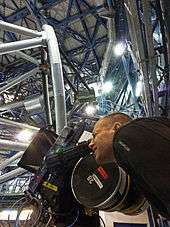
Many IMAX films have been remastered into HDTV format (cropped to fit into HDTV's 16:9 aspect ratio) for the MOJO HD, HDNet and HD Theatre networks and release on DVD and Blu-ray Disc. In July 2005 the BFI IMAX Cinema in London became the first to host live music concerts, using a digital non-IMAX projector. The Science Museum London and BFI IMAX Cinema have also hosted computer game tournaments using digital projectors. Several amusement park attractions have integrated IMAX film segments, including Back to the Future: The Ride formerly at Universal Studios in Florida and California, Horizons formerly at Epcot and Soarin' Around the World at Disney California Adventure Park and Epcot.
Technical specifications
IMAX (15/70)
- spherical lenses
- 70 mm film, 15 perforations per frame
- horizontal rolling loop movement, from right to left (viewed from emulsion side)
- 24 frames per second
- camera aperture: 70.41 mm × 52.63 mm (2.772 in × 2.072 in)
- projection aperture: at least 2 mm (0.079 in) less than camera aperture on the vertical axis and at least 0.41 mm (0.016 in) less on the horizontal axis
- aspect ratio: 1.43:1
- DMR aspect ratio: 1.90:1, 2.39:1
IMAX Dome/Omnimax
Same as IMAX except:
- fisheye lenses
- lens optically centered 9.4 mm (0.37 in) above film horizontal center line
- projected elliptically on a dome screen, 20° below and 110° above perfectly centered viewers
Gallery
 The Cinesphere in Toronto, the first IMAX theatre in the world
The Cinesphere in Toronto, the first IMAX theatre in the world

- IMAX Port Vell, at Barcelona, Spain
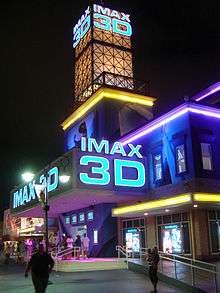 IMAX 3D at "Broadway at the Beach", at Myrtle Beach, South Carolina
IMAX 3D at "Broadway at the Beach", at Myrtle Beach, South Carolina The VieShow Theatre in Taipei, Taiwan
The VieShow Theatre in Taipei, Taiwan An IMAX theatre located in the Tennessee Aquarium at Chattanooga
An IMAX theatre located in the Tennessee Aquarium at Chattanooga British Film Institute (BFI) London IMAX
British Film Institute (BFI) London IMAX- IMAX film theatre in the Esquire Tower, Sacramento, California
 An IMAX theatre in Warsaw, Poland
An IMAX theatre in Warsaw, Poland IMAX 3D cinema in Eilat, Israel
IMAX 3D cinema in Eilat, Israel- Bucharest, Romania IMAX
 The IMAX Peace Cinema in Shanghai, China
The IMAX Peace Cinema in Shanghai, China IMAX-Cinema in Vienna, which closed on November 16, 2005
IMAX-Cinema in Vienna, which closed on November 16, 2005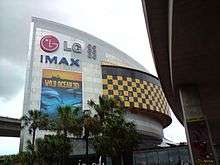 LG IMAX in Sydney, Australia. Formerly largest screen in the world, closed for redevelopment until 2019.
LG IMAX in Sydney, Australia. Formerly largest screen in the world, closed for redevelopment until 2019. IMAX at the Melbourne Museum in Melbourne, Australia. Current largest screen in the world.[108]
IMAX at the Melbourne Museum in Melbourne, Australia. Current largest screen in the world.[108]- SAIMAX IMAX Theater at San Antonio, Texas, United States
 IMAX at the National Museum of the United States Air Force – Dayton, Ohio
IMAX at the National Museum of the United States Air Force – Dayton, Ohio IMAX Cinema in Glasgow, Scotland
IMAX Cinema in Glasgow, Scotland


 The now-defunct IMAX dome theatre at the Museum of Science and Industry in Tampa, Florida
The now-defunct IMAX dome theatre at the Museum of Science and Industry in Tampa, Florida Regal Winrock Stadium 16 IMAX & RPX in Albuquerque, New Mexico
Regal Winrock Stadium 16 IMAX & RPX in Albuquerque, New Mexico PVR Imax in The Forum (shopping mall) Bangalore
PVR Imax in The Forum (shopping mall) Bangalore
Competitors
In late 2014, Dolby announced Dolby Cinema as an IMAX competitor with super-vivid image mainly in High Dynamic Range with shadow.[109] In Australia and New Zealand, Event Cinemas sells a premium cinema experience with a bigger screen, improved imagery and better seats marketed as Vmax. In the United States Cinemark has its Cinemark XD: Extreme Digital Cinema.[110][111][112][113]
See also
- List of IMAX DMR films
- List of IMAX films
- List of IMAX venues
- List of IMAX-based rides
- China Film Giant Screen, a similar format developed to break IMAX's large-screen monopoly in China
- Dolby Cinema
- RealD Cinema
References
- "The Birth of IMAX". Ieee.ca. Retrieved May 23, 2012.
- How Regular Movies Become "IMAX" Films, by Mark Wilson (Gizmodo.com, published May 29, 2009)
- 70 mm Grandeur film
- see U.S. Patent 3,494,524
- IMAX at 30: An Interview with Graeme Ferguson by Wyndham Wise (originally published in Take One magazine, Issue #17, Fall 1997)
- "Shutter assembly".
- "Managing IP, INTA Daily News article".
- "IMAX'S Chronology of Techonological (sic) Events". IEEE Canada, Institute of Electrical and Electronics Engineers. Retrieved February 23, 2010.
- "Corporate, History & Milestones". IMAX.com. Archived from the original on July 4, 2010. Retrieved July 3, 2010.
- Cheng, Jennifer (November 3, 2017). "Inside the newly restored Cinesphere at Ontario Place". Toronto Life. Toronto Life Publishing Company Limited. Retrieved November 11, 2018.
- "Imax theater in Riverfront Park headed for demolition; fate of pavilion rides still in question". The Spokesmen-Review. September 30, 2016. Retrieved May 24, 2017.
- "US Pavilion & Shelters". City of Spokane. Archived from the original on February 16, 2016. Retrieved May 24, 2017.
- "2014 Riverfront Park Master Plan" (PDF). City of Spokane. Retrieved June 1, 2017.
- "IMAX Theatre". Imax.com. October 1, 2009. Retrieved July 3, 2010. (official site).
- IMAX Corporation (February 24, 2016). "IMAX Corporation Reports Fourth-Quarter And Full-Year 2015 Financial Results" (Press release). PR Newswire. Retrieved February 24, 2016.
- "IMAX Corporation Form 10-K for the fiscal year ended December 31, 2007" (PDF). March 14, 2008. Retrieved February 29, 2016.
- GmbH, finanzen.net. "IMAX and Cineplex Launch Canada's First IMAX VR Centre at Scotiabank Theatre Toronto - Markets Insider".
- Maintaining The IMAX Experience, From Museum To Multiplex, by Elizabeth Blair (NPR.org, May 2, 2014)
- The Shrinking IMAX Screen, originally published in the LF Examiner, April 2010
- PR Newswire (November 17, 2017). "IMAX and Cineplex Launch Canada's First IMAX VR Centre at Scotiabank Theatre Toronto". markets.businessinsider.com. finanzen.net GmbH.
- "/Film Interview: IMAX Executives Talk 'The Hunger Games: Catching Fire' and IMAX Misconceptions". Slash Film. December 2, 2013. Retrieved December 17, 2013.
- Wilson, Mark (May 29, 2009). "How Regular Movies Become "IMAX" Films". Gizmodo. Gawker Media. Retrieved March 7, 2016.
- "Phantom 65 used in the "Wild for IMAX 3D shoot". abelcine.com. May 2012. Archived from the original on October 20, 2012.
- "IMAX debuts digital 3D camera". tvbeurope.com. May 2012. Archived from the original on August 25, 2013.
- Lang, Brent (April 13, 2015). "'Captain America: Civil War' First to Use New Imax/Arri 2D Camera (Exclusive)". Variety. Archived from the original on April 14, 2015. Retrieved April 13, 2015.
- Eagan, Daniel (June 12, 1017). "Ready for Prime Time: Michael Bay helms fifth episode in the Transformers series in native, real-time 3D". Retrieved November 24, 2017.
- Brain, Marshall. "Howstuffworks "How IMAX Works"". Howstuffworks.com. Retrieved August 14, 2020.
- Knight, Courtney Crowder and Jessica. "10 facts about Des Moines' Blank IMAX". Des Moines Register.
- Kodak's trade name for biaxially oriented PET film
- "How IMAX Works". HowStuffWorks. August 3, 2001.
- Author, Guest. "The staggering size and scale of IMAX". www.redsharknews.com.
- Mendelovich, Yossy (March 10, 2020). "IMAX Filmmaking: What is it like to Shoot on an IMAX Film Camera?".
- "Big Enough for Everest: Inside IMAX Sound". DigitalContentProducer.com. June 1, 1999. Retrieved April 26, 2017.
- "The Basics of The Rolling Loop IMAX Projector". www.in70mm.com.
- "The 15/70 Filmmaker's Manual" (PDF). Imax. Archived from the original (PDF) on December 29, 2009. Retrieved December 29, 2009.
- "IMAX Corporation Selects Barco as Exclusive, Worldwide Projection Technology Partner for IMAX Theatres". 3droundabout.com.
- Slater, Jim (December 2008). "IMAX Digital: It's IMAX, but not as we know it, Jim!" (PDF). Cinema Technology. pp. 38–41. Archived from the original (PDF) on March 10, 2016. Retrieved February 29, 2016.
- "IMAXimum impact: Studio movies go big with large-format leader". filmjournal.com. May 2012.
- Palazzo, Anthony (May 2012). "Imax Tests Laser Projector Built With Kodak Patents". bloomberg.com.
- Verrier, Richard (April 15, 2015). "Imax premieres new laser system at TCL Chinese Theatre in Hollywood". The Los Angeles Times. Retrieved March 7, 2016.
- "IMAX with Laser is here". IMAX (Press release). April 1, 2015. Retrieved March 7, 2016.
- "IMAX Shows Off Its First U.S. Laser-Projection System". Retrieved December 18, 2015.
- Anthony, Sebastian. "IMAX with laser: Superb contrast, 4K resolution, and huge color gamuts". Retrieved December 18, 2015.
- Lussier, Germain (April 22, 2015). "Is IMAX Laser Projection The Future Of The Movies?". Slashfilm. Retrieved March 7, 2016.
- Roberts, Becky (October 2, 2015). "IMAX launches laser projection system in UK – and it looks spectacular". whathifi.com. Retrieved March 7, 2016.
- "Imax Laser-Illuminated Projection at TCL Chinese Theatres". HDGENIUS. November 16, 2015. Archived from the original on April 15, 2017. Retrieved April 14, 2017.
- Giardina, Carolyn. "Imax Expands Footprint in Theaters With Launch of New Laser Projection System". The Hollywood Reporter. Retrieved April 25, 2018.
- "Imax". Retrieved July 3, 2010.
- "The Omnimax Theatre". Great Lakes Science Center. June 27, 1996. Archived from the original on September 22, 2010. Retrieved July 3, 2010.
- World's biggest movie screen - 29.7m high and 35.7m wide - installed at Sydney Imax Archived May 3, 2016, at the Wayback Machine. News.com.au - February 10, 2012. Retrieved September 14, 2013.
- "Archived copy". Archived from the original on October 16, 2016. Retrieved 2007-03-18.CS1 maint: archived copy as title (link). Retrieved September 14, 2013.
- "About Us | IMAX Melbourne". imaxmelbourne.com.au.
- "Which Country has the Biggest Movie Theater in the World?". March 23, 2017.
- "We're getting a make-over! - IMAX Sydney". Retrieved December 2, 2018.
- "Elcan.com". Archived from the original on March 17, 2010.
- Cox, Aidan (February 29, 2016). "History Museum theatre upgrades into the future". Ottawa Citizen. Retrieved April 3, 2020.
- "Tietomaan jättielokuvateatteri digiaikaan". Oulun kaupunki - www.ouka.fi. May 27, 2014.
- "Science Centre Singapore". July 27, 2015.
- "National Museum of Natural Science". July 27, 2015.
- "Liberty Science Center". April 18, 2017.
- Aitken, Ian (October 27, 2005). Encyclopedia of the Documentary Film. Routledge. pp. 168–9. ISBN 978-1579584450.
- St-Pierre, Marc (July 23, 2010). "The NFB and World Fairs, pt. 4: Seville and Expo 92". NFB.ca Blog. National Film Board of Canada. Retrieved June 12, 2012.
- "IMAX Corporation – Company History". Fundinguniverse.com. Retrieved July 3, 2010.
- Tang, Calvin (August 15, 2010). "Interview with Underwater Filmmaker Howard Hall". AtlasOmega. AtlasOmega Media, LLC. Retrieved March 29, 2016.
- Hyder, James (October 16, 2008). Is IMAX the next "New Coke"? LF Examiner, October 16, 2008. Retrieved from LFexaminer.com. Archived October 30, 2016, at the Wayback Machine
- "But...but...IT's NOT IMAX!". Rogerebert.suntimes.com. Retrieved May 23, 2012.
- Burr, Ty (July 17, 2017). "What's the best format for viewing 'Dunkirk'?". The Boston Globe. Retrieved May 5, 2018.
- Quenneville, Guy (May 3, 2018). "Imax responds to Saskatoon 'Liemax' claim, says there's more to it than screen size". CBC News. Retrieved May 5, 2018.
- Pogue, David (May 18, 2016). "New Imax Shift". YahooTech. Retrieved May 18, 2016.
- "IMAXShift". imaxshift.com. Retrieved May 31, 2017.
- Pegoraro, Rob (August 31, 2016). "IMAX wants to add VR to your next movie". Yahoo! Finance. Retrieved December 21, 2018.
- Roettgers, Janko (December 13, 2018). "Imax Is Shutting Down Its VR Business, Closing Remaining Three VR Centers in Q1". Variety. Retrieved December 21, 2018.
- Roettgers, Janko (January 4, 2017). "Imax to Open VR Experience Center in Los Angeles This Week". Variety. Retrieved December 21, 2018.
- "BLOG @ IMAX: Close Call". Imax.com. June 18, 2012. Archived from the original on October 30, 2012. Retrieved November 7, 2012.
- Studio Briefing (November 9, 2009). "As Expected, IMAX Reports A Loss". Culture.com. Retrieved June 20, 2012.
- McClintock, Pamela (May 10, 2009). "'Star Trek' beams up $76.5 million". Variety.
- QMI Agency (April 28, 2010). "IMAX inks 20-film deal with Warner Bros". Toronto Sun. Retrieved May 23, 2012.
- Vlessing, Etan. "Marvel's 'Avengers: Infinity War' to be Shot Entirely with Imax/Arri 2D Camera". The Hollywood Reporter. Retrieved May 7, 2015.
- "'Captain America: Civil War' First to Use IMAX/Arri 2D Camera". IMAX. Retrieved April 29, 2016.
- "Marvel's 'Avengers: Infinity War' To Be Filmed Using The IMAX/Arri Digital Camera". Marvel. Archived from the original on January 21, 2016. Retrieved April 29, 2016.
- "Change Comes To LFCA. 2004 LFCA". In70mm.com. Retrieved July 3, 2010.
- Clement, Nick (March 8, 2018). "Christopher Nolan, Emma Thomas on 'Wow Moments' Filming in Imax". Variety. Retrieved June 1, 2018.
- "How The Dark Knight Went IMAX". Slash Film. June 14, 2008. Retrieved January 23, 2011.
- "3D a 'Flash in the Pan' – 'Inception' Cinematographer". The Wrap. November 12, 2010. Retrieved January 23, 2011.
- Lang, Brent (May 7, 2015). "'Avengers: Infinity War' to Be Shot Entirely With Imax Cameras". Variety. Variety Media, LLC. Retrieved March 7, 2016.
- Warner Bros. Pictures press notes, The Dark Knight
- Seymour, Mike (July 21, 2008). "Dark Knight : Imax, Effects and That Bike". fxguide.com. Retrieved March 7, 2016.
- "Exclusive Video: Director Michael Bay talks Transformers Revenge of the Fallen". Collider. February 9, 2009. Retrieved April 16, 2010.
- "Exclusive: Michael Bay Reveals TRANSFORMERS 4 Will Shoot the 'Showcase Scenes' With the New IMAX 3D Digital Camera". Collider.com. April 15, 2013. Retrieved April 17, 2013.
- "Paramount Pictures and IMAX Pact for Four Films in 2011". Giant Screen Cinema Association. January 10, 2011. Retrieved January 18, 2011.
- "'Mission Impossible' To Open Early On IMAX". Paramount Pictures press release. October 5, 2011. Retrieved October 27, 2011 – via Deadline Hollywood.
- "Brad Bird: 'Mission: Impossible' opening early at IMAX". Indiewire. September 28, 2011. Retrieved October 27, 2011.
- "VP of IMAX talks 'The Dark Knight Rises'". Batman-News.com. October 27, 2010. Retrieved December 28, 2010.
- "'Star Trek' Sequel Is Being Shot Partially On IMAX". Slash Film. February 24, 2012. Retrieved February 25, 2012.
- Sullivan, Kevin P. (June 13, 2012). "'Hunger Games: Catching Fire' To Light Up IMAX Screens - Music, Celebrity, Artist News". MTV.com. Retrieved November 7, 2012.
- "Universal Pictures and Europacorp's "Lucy" Races into International IMAX® Theaters Starting August 8". PRN Newswire. IMAX Corporation. July 8, 2014. Archived from the original on April 3, 2015. Retrieved August 3, 2014.
- "'Interstellar' and 'Transformers 4' to Shoot in IMAX; Michael Bay Will Use New IMAX Camera For Native 'T4' 3D". slashfilm.com. April 15, 2013. Retrieved April 17, 2013.
- "Archived copy". Archived from the original on July 14, 2014. Retrieved 2014-07-11.CS1 maint: archived copy as title (link)
- O'Donnell, Kevin (October 23, 2015). "Inside the top-secret making of Adele's powerful 'Hello' video". Entertainment Weekly. Retrieved October 26, 2015.
All of it is shot on film. The shots on IMAX are two shots: mostly the finale on that pond, and there's the shot of her opening her eyes.
- Lang, Brent (April 13, 2015). "'Captain America: Civil War' First to Use New Imax/Arri 2D Camera (EXCLUSIVE)". variety.com. Retrieved July 6, 2016.
- "Archived copy". Archived from the original on October 22, 2016. Retrieved 2016-10-06.CS1 maint: archived copy as title (link)
- "How 'Tenet' Prologue Sets Up a Time-Bending Story". The Hollywood Reporter.
- "IMAX 3D Theater | Kennedy Space Center Visitor Complex". www.kennedyspacecenter.com. Retrieved April 18, 2017.
- Stromberg, Joseph. "The Space Shuttle's IMAX Cameras Touch Down at Air and Space". Smithsonian. Retrieved April 18, 2017.
- "IMAX Corporation: Information from". Answers.com. Retrieved July 3, 2010.
- "Imax Corp. Earns Academy Award For Technical Achievement. – Free Online Library". Thefreelibrary.com. January 7, 1997. Archived from the original on October 10, 2017. Retrieved July 3, 2010.
- "ESO Goes IMAX 3D". ESO Announcements. Retrieved December 3, 2012.
- "Melbourne's IMAX Screen Is Now The World's Largest (Because Sydney's Was Demolished)". Gizmodo Australia. September 29, 2016. Retrieved August 19, 2019.
- Moon, Mariella (December 7, 2014). "Dolby Is Launching Its Super-vivid IMAX Competitor in the Netherlands". Engadget. Retrieved December 7, 2014.
- "Cinemark XD". Cinemark. Retrieved May 16, 2017.
- bigonkiss (March 16, 2013). "Cinemark Introduces Us To Their Incredible New XD: Extreme Digital Cinema Theater [VIDEO]". Lubbock, TX: 102.5 Kiss FM. Retrieved May 16, 2017.
- Kerns, William (September 6, 2011) [September 5, 2011]. "Cinemark Makes Moviegoing More Attractive with XD Presentation". Lubbock Avalanche-Journal. Retrieved May 16, 2017.
- BoxOffice Staff (May 4, 2017). "Cinemark Partners with THX to Certify XD Auditoriums" (Press release). BoxOffice Pro. Business Wire. Retrieved May 16, 2017.
External links
| Wikimedia Commons has media related to IMAX. |
- IMAX.com, the official Web site
- Large Formats, Describes the differences between the three different "large-format" or "giant-screen" formats, the IMAX Digital format, and the conventional formats.
- IMAX Soundtracks Database, IMAX Soundtracks Database
- YouTube videos explaining the theater operation and maintenance processes of threading & playing a 70mm IMAX film, building a film ( alt) by splicing together 40 reels shipped in 7 boxes making one feature-length film 9 miles long weighing 1,200 pounds, and replacing the projector's xenon lamp ($5600 bulb cost).